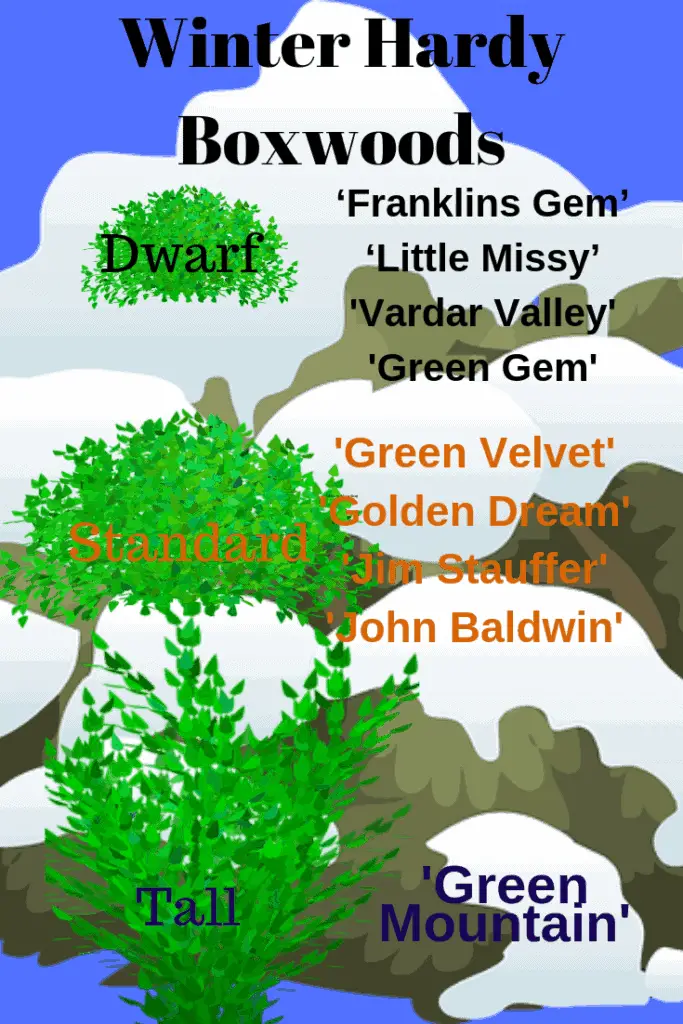Have you had trouble with boxwoods thriving through the winter? Not all boxwoods are the same, they may look very similar, but different varieties can shake off a cold winter better than others! After narrowing down to which ones are winter-friendly.. then which ones naturally grow to the size or shape you are looking for? Save yourself so much time, headache and pruning by selecting for size and shape too.
These varieties are the cold-hardiest of the boxwoods, American boxwoods, hybrids, and Korean boxwoods. Cold hardiness is the place to start when planning for boxwoods in colder regions, zone 5(US), -23℉ (-13℃), and colder. English boxwoods are too easily winter-damaged to be in this post.
Japanese (Korean) Boxwoods, Buxus microphylla var insularis
- ‘Wintergreen’
- ‘Franklins Gem’
- ‘Little Missy’
- ‘Golden Dream’
- ‘Green Beauty’
- ‘Jim Stauffer’
- ‘John Baldwin’
American Boxwoods, Buxus sempervirens
- ‘Vardar Valley’
- The Green Series too, of course, English Boxwood X Korean Boxwood hybrids
- ‘Green Mountain’
- ‘Green Velvet’ almost indistinguishable from ‘Chicagoland Green’
- ‘Green Gem’
- ‘Green Mound’
Click here to read all about choosing and planting boxwood.

These are the cold-hardiest boxwoods of the bunch. The Green Series in particular were introduced from out of a Canadian breeding program.
Winter Hardiness is more than just the absolute temperature the plant can withstand, even though that is part of it. A broad-leaved evergreen like boxwood needs to be able to conserve water in the winter. When the ground freezes, no more water can be absorbed, because it is frozen. However, the sun is beating down, trying to take moisture from those leaves. The wind is blowing, stripping water from those broad leaves. A boxwood needs to have protection in the winter to conserve that water. Often this is by a thick waxy coating on the leaves for protection.
For an ever-updated document comparing boxwood varieties, click here.
If you are finding the wind is drying out your boxwoods, spray with wilt-pruf, an anti-desiccant, that will help conserve that moisture, and lead to less damage come spring. Click here to pick some up from Amazon.
To get the best plants for your situation every time, click here.
Related Questions:
Why do my boxwoods turn yellow in the winter?
There are a few reasons this can be happening. One is boxwoods can turn yellow in the winter in reaction to a warm spell. The warm temperatures triggered the fluids to start flowing up from the roots into the tissues, where it then freezes and causes damage when the temperatures plummet at night. This happens more often in boxwoods grown in the sun. As odd as it seems, it is the sun in the winter that the boxwoods have more trouble with, as opposed to the sun in the summer. For those of you that have concerns about winter hardiness, give some thought to where you are planting, and how much sun, especially the afternoon sun, the boxwood will get.
Another common cause is winter chlorosis. I couldn’t say it better than Douglas Justice “ It is hard to diagnose precisely, but a variety of issues could be the cause. It is most common where roots have been damaged (e.g., from drought, drowning, disease, dog pee, etc.), and in cold, strongly acidic, nutrient-deficient, compacted or water-logged soils. Manganese toxicity, which is common in the winter in manufactured soils (especially when there is a high bark content), can look like this. It is usually most severe when soil iron and especially nitrogen are in short supply (as is common in winter). The chlorosis usually disappears when the weather warms in June.” ¹
Yellow edging on leaves, especially with sharply delineated edges and tips can be a magnesium deficiency. Check your soil pH, too acid and the magnesium that is there will not be available to your boxwood. Adjust pH tp be between 6.0- 7.2. Use dolomitic lime if you need to increase the pH. Epsom salts can help as a foliar spray with a mild deficiency. Epsom salts are 10% magnesium. Mix 1 Tablespoon Epsom salts to 1 gallon of water and spray on the leaves.
If the boxwood quickly recovers in the spring with new growth, it will be fine, and not to worry, especially if you are closer to the too cold edge of the winter hardiness zone for boxwoods.
How to deal with winter burn on boxwood?
Winterburn in boxwoods is when the leaves have turned tan or brown can be dealt with in a couple of ways. One is to prune back to green leaves. Another is to wait for new growth and see where any twig dieback is if any and prune back to live wood. Winter burn happens when the damage has already happened and killed cells in your boxwood. The twig may or may not still be alive.
Test it by scraping a little bit of the bark, if the wood is brown and dry under the bark, the twig is dead to there, and cut back until you see wood being exposed that is lighter in color, green tint, and moister. If you do the test and have dead and live wood, try it, and you will see the difference. Also, deadwood snaps when bent, live wood bends.
You can wait to do your pruning just as new growth has started, that will show you where the wood is live and where it is dead, so it is easy to see where you cut back to. If you miss that small window of time that the buds are just starting to swell, then wait a month or so for the fresh growth to harden off before pruning if you are pruning with hedge shears and will be invariably cutting leaves too. The recovery will be quicker and with less browning on tender cut leaf edges.
How do I protect my boxwoods in the winter?
First and foremost, plant boxwoods that are hardy for your area. These have been proven to be more resilient against the harshness of winter.
Second, plant them where they are getting partial shade. Shade in the afternoon or filtered sun in the afternoon is best.
Next, make sure that you have deeply watered your boxwoods before the ground freezes. This ensures your boxwood is fully hydrated for the winter, helping ward off dehydration tissue damage.
Spray with an anti-desiccant like WiltPruf (to help retard the water loss from wind and sun when the ground is frozen and water is not available for your boxwood to uptake. If you need some. Click here to find it on my favorite things page.
Install windbreaks around or on the windward side of boxwoods. A sheet of burlap at least a foot or two away from the boxwood is good to cut the wind.
Protect from heavy snow loads that can cause branch breakage. Putting up a slatted ‘roof’ over your boxwood, leaving plenty of room for air circulation, in areas of heavy snows will preserve your boxwood from breaking under the weight of the collected snow.
The important things to remember are: protect from drying out after the ground is frozen, and continue to have good airflow to reduce disease. DO NOT wrap or cover in plastic or any other material that cannot breathe.
¹https://forums.botanicalgarden.ubc.ca/threads/my-boxwoods-have-a-yellow-leaf-edge-deficiency.92620/


